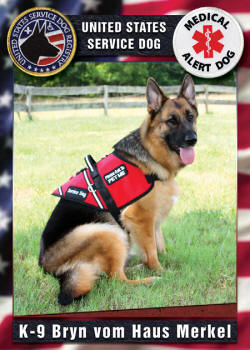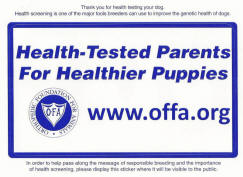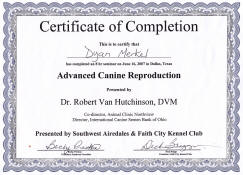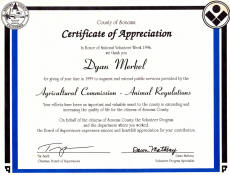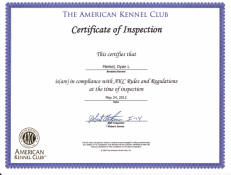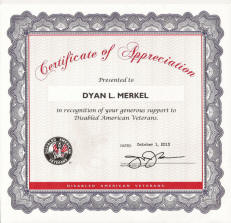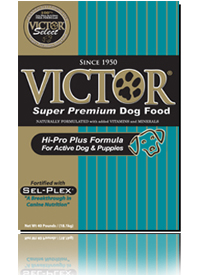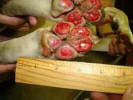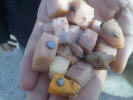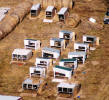|
The breed survey is the
ultimate instrument used as the selection method
for the German Shepherd Dog Breed. It is absolutely necessary for the
preservation and advancement of this breed.
Originally developed in
Germany for their domestic stock, in 1922 the breed
survey also became the tool used as a resource for breeding the German
Shepherd Dog. Simply explained, German Shepherd Dogs need a
certificate for reproduction.
This certificate is issued
by the USA/SV organization which follows a
special procedure where the breed survey judge evaluates the dog’s
temperament in different stimulus situations. The dog must always
demonstrate a friendly and self-confident character and in any situation,
must show control even when in confrontation with its own natural instincts.
After these tests the dog
will be measured, weighed, and anatomically analyzed
in the stand position and also, when in movement. Based on each dog’s
overall evaluation, it will be awarded the predicate Class I or Class II.
Of course,
not all dogs will be able to reach the level of these certificates.
The requirements to enter
a dog in the breed survey event are not easy to
achieve. They must be registered with the SV/USA organizations,
absolutely healthy, a minimum of 2 years of age, they must have
successfully completed an endurance test, received a rating of at least
“good” in a breed show, they must have obtained at least a performance title
of
SchH 1 and must have certified hips. This may seem to be very restrictive,
but it makes sense since we are looking for animals within our whole
breed population, which have been selected based on their
temperament, performance, and anatomy to improve and advance the breed.
This is an ideal
tool for breeders to be able to carefully plan all their future breedings.
USA Breed Survey Regulations
1.
GENERAL
The United Schutzhund Clubs of America (USA) is a German Shepherd Dog breed
organization guided by the rules of the founding organization of German
Shepherd Dogs, the Verein für Deutsche Schäferhunde (SV) in Germany, with
the objective of preserving the breed in accordance with the breed standard
as a working dog. The USA Breed Survey Regulations coincide with the SV
regulations; however, they have been somewhat modified to conform to the
needs of USA.
The USA Breed Survey
Regulations govern all breed survey activities for the German Shepherd Dog.
The purpose of the USA Breed Survey Regulations is to select breeding
animals that, according to their temperament, performance, and anatomical
characteristics, are suitable for maintaining and improving the breed.
2. USA SURVEY ORGANIZATION
2.1.
Breed Book Office
The USA Breed Book Office
checks all breed survey paperwork for correctness, then processes and files
the reports. The USA Breed Book Office publishes a USA Breed Survey Book
annually containing the data on all dogs that have been breed surveyed in a
USA event.
2.2.
Breed Survey Masters
USA appoints experienced USA
breed judges to serve as breed survey masters and also uses SV Körmeisters.
The breed survey masters have no legal claim to yearly breed survey
assignments. Selection of breed survey masters lies with the local clubs.
2.3.
Breed Survey Season
The season
for breed surveys is from January 1st through December 31st
of each year. Dogs may be presented for surveying one time during each
season.
2.4.
Breed Survey Entry Maximum
The number of dogs for each
survey day is limited to 50. If more than 50 dogs are entered, an additional
half-day must be added on the same weekend.
2.5.
Legal
2.5.1.
The decision of the breed survey master is final. Objections are not
permitted.
2.5.2.
Obtaining or losing breed survey status gives no legal claims to interested
parties or outsiders. Any claims for damages from interested parties
(owners) or outsiders arising from obtaining or losing breed survey status
are denied.
2.5.3.
The owner of the dog is liable for any damage caused by the dog.
3. PREREQUISITES FOR BREED SURVEY PARTICIPATION
3.1.
USA Registration
Dogs must be registered with USA if
the owner resides in the United States.
3.2.
USA Membership
Owners of the dogs must be
current members of USA if residing in the United States. If the dog is
co-owned, the signature-authorized owner must be a current USA member.
3.3.
Age Requirement
Dogs must be
a minimum of two years old in the year of the survey.
3.4.
Performance Title
Dogs must have at least one
performance title (SchH1-3, VPG1-3, IP1-3, or HGH) obtained under a
USA-recognized performance judge, and a BH obtained under a WUSV-recognized
judge. Dogs with an HGH title are not required to have a BH title.
3.5.
Endurance Test
Dogs must have passed an
endurance test (AD) under a USA-recognized judge; however, this requirement
is waived for dogs with an HGH title and dogs that are six years and older.
3.6.
Hip Certification
Dogs must have a
USA-recognized hip certification with tattoo number or microchip
identification. Note: Check with the USA Office for a current list of
recognized hip certifications.
3.7.
Breed Show Rating
Dogs must have a breed show
rating of at least “good” obtained under a USA-recognized breed judge in the
youth, young dog, or working dog class.
3.8.
USA-Recognized Judges
The judges who are
recognized by USA are USA judges, SV judges (including SV foreign judges),
and Canadian judges.
3.9.
Additional Prerequisites
3.9.1. Sick animals may not be presented.
3.9.2. Females in season must be reported to the breed survey master, who
controls participation.
3.9.3. Females in whelp must be reported to the breed survey master, who
controls participation.
3.9.4. Dogs must be identifiable by a recognizable tattoo number.
4. SPONSORING LOCAL CLUBS
4.1. Prerequisites
4.1.1.
Venue with the necessary accommodations and
restrooms
4.1.2.
Trained assistants
4.1.3.
Breed survey secretary
4.2. Required
Equipment
4.2.1.
Shelter for the breed survey master and breed survey secretary
4.2.2.
Sufficiently large ring
4.2.3.
Loudspeaker
4.2.4.
SV breed survey measuring stick
4.2.5.
Measuring tape (metric system)
4.2.6.
Scale (metric system)
4.2.7. Two
blank guns (6 mm) with adequate blank ammunition
4.2.8.
Numbered bibs or armbands for dog handlers
4.3. Duties of Breed Survey
Secretary
4.3.1.
Mail breed survey entry forms a minimum of
three weeks in advance.
4.3.2. Check
submitted documents for completeness and correctness, and check eligibility
of dogs for entering breed survey.
4.3.3.
Confirm that owners who are residents of the United States are USA members
4.3.4.
Prepare
Körlisten and temporary breed survey certificates and have them ready for
the breed survey master either prior to or at the start of the survey. The
forms are available from the USA Breed Book Office.
4.3.5. Inform
the breed survey master regarding receipt and number of entries.
4.3.6.
Provide a catalogue-like list of participants that is divided by males and
females, and first and repeat breed surveys.
4.3.7. Submit
the checked documents for each dog to the breed survey master before the
start of the breed survey.
5. REGISTERING FOR THE SURVEY
The following documents must
be submitted no later than the day of the breed survey:
5.1.
Original USA-recognized pedigree showing proof of USA registration.
5.2.
Original breed show rating book/card showing proof of breed show rating.
5.3.
Original scorebook showing proof of AD, BH, and one performance title.
5.4.
Original hip certificate showing proof of USA-recognized hip certification
with tattoo number or microchip identification, if not entered on the
pedigree.
5.5.
Original breed survey report in cases of resurvey.
5.6.
Original signature authorization form for dogs that are co-owned, unless
previously submitted to the USA Breed Book Office (form available from the
USA Breed Book Office).
5.7.
Photocopy of USA membership card.
6.
SURVEY PROCEDURE
6.1.
Temperament Test
The breed survey master must
subject each dog to a temperament test. Temperament evaluation may extend
throughout the entire survey. According to the standard, the dog must
display sound temperament; i.e., be carefree, self-confident, and
good-natured and have steady nerves.
6.2.
Gun Test
From a distance of at least
15 paces, at least two shots must be fired from a blank gun (6 mm). The dog
must not have a negative reaction to the gunfire.
6.3
Protection Work Execution – Surprise Attack with Guarding
6.3.1. The handler reports to the breed survey master with the dog on
leash.
6.3.2. Upon instruction by the breed survey master, the handler assumes the
basic position at a marked spot 30 paces from the blind and takes the leash
off the dog.
6.3.3. The leash must be placed around the shoulder or in the pocket of the
handler.
6.3.4. Upon a signal from the breed survey master, the handler walks toward
the blind with the free-heeling dog.
6.3.5. The dog must stay closely at heel.
6.3.6. Upon a signal from the breed survey master, the helper performs an
attack while making threatening noises. The attack occurs when handler and
dog are five paces away from the blind.
6.3.7. The dog must counter the attack immediately and confidently and must
bite hard and full.
6.3.8. Once the dog has a grip on the sleeve, the helper applies two stick
hits with a soft stick on either the thighs, the sides, or in the area of
the withers.
6.3.9. The handler may verbally encourage the dog to counter the attack.
6.3.10. Upon a signal from the breed survey master, the helper stops the
attack and stands still.
6.3.11. The dog must release either on its own or upon receiving the verbal
command “aus/out” and must guard the helper.
6.3.12. The breed survey master gives the handler the instruction to step
up to the dog.
6.3.13. The handler puts the dog on leash and receives the instruction from
the breed survey master to step into the assigned blind.
6.4.
Protection Work Execution
–
Attack, Fight, and Guarding
6.4.1. The breed survey master tells the handler to leave the assigned
blind and take the position on the centerline.
6.4.2. The handler takes the dog off leash and holds the dog by the collar.
6.4.3. The dog must stay in this position until he is sent to counter the
attack with the verbal command “voran/go on.”
6.4.4. Upon receiving a signal from the breed survey master, the helper
leaves the assigned blind, which is located at a distance of approximately
70-80 paces from the handler, and walks across the field at a normal pace.
6.4.5. The handler verbally commands the helper to stop by shouting
“stop/stand still.”
6.4.6. The helper ignores the command and performs a frontal attack on the
handler and the dog.
6.4.7. Immediately after the attack begins, the breed survey master gives
the handler the instruction to counter the attack/send the dog.
6.4.8. The handler immediately sends his dog with the verbal command
“voran/go on” and stands still.
6.4.9. The dog must energetically counter the attack with drive and with a
strong, full, sure, and calm grip.
6.4.10. Once the dog has a grip on the sleeve, and after a brief pressure
phase, the helper stops the attack on a signal from the breed survey master.
No stick hits are given.
6.4.11. Thereafter, the dog must release either on its own or upon
receiving the verbal command “aus/out” and must guard the helper.
6.4.12. Upon a signal from the breed survey master, the handler walks
directly to the dog at a normal pace and puts the dog on leash.
6.4.13. With the dog on leash, the handler reports to the breed survey
master and then leaves the field.
6.5.
Protection Work Scoring – Release
6.5.1. After the helper stops the attack, the dog must release on its own.
6.5.2. The handler may give the first “aus/out” command on his/her own
after a reasonable time.
6.5.3. If the dog does not release after the first “aus/out” command, the
breed survey master instructs the handler to give two more “aus/out”
commands, if necessary.
6.5.4. When giving the “aus/out” command, the handler must stand still and
may not influence the dog in any way.
6.5.5. If the dog's name is used, it is counted as an “aus/out” command.
6.5.6. If the dog releases on its own when the handler approaches, it can
still be counted as a release; however, the handler must be at least five
paces from the dog at that time.
6.5.7. If the dog releases on its own or in response to the “aus/out”
command after the attack and after the defense exercise; the rating “does
release” is awarded.
6.5.8. If the dog does not release—even once—on its own or in response to
the “aus/out” command after the attack or after the defense exercise, the
dog receives the rating “does not release.”
6.5.9. The breed survey ratings themselves are not affected by this rating.
6.5.10. The breed survey master stays near the handler during the entire
protection routine, and keenly observes the behavior of dog and handler
until after the handler has picked up the dog.
6.6.
Protection Work Scoring – Evaluation of Instinctive Behavior,
Self-Confidence, and Ability to Cope with Stress (TSB)
6.6.1.
The overall rating of the protection exercises is scored as “pronounced,”
“present,” or “insufficient.”
6.6.2.
Pronounced: Self-confident, intense, goal-oriented and secure gripping and
holding, no negative reactions to the stick hits, and close and attentive
watching in the guarding phases.
6.6.3.
Present: Deficiencies, for example, in self-confidence, in goal-oriented
behavior, in grip and stick behavior, as well as in the guarding phases.
6.6.4.
Insufficient: Lacking self-confidence, strong deficiencies with respect to
hardness, and disinterest in the helper.
6.7.
Measurements and Weights
The breed survey secretary
or an assistant may weigh the dogs and take measurements for chest depth and
chest circumference. The breed survey master must take measurements of the
height at the withers.
6.8.
Examination of Standing Dog and Evaluation of Movement
During this examination, the
breed survey master writes the breed survey report. The handler must refrain
as much as possible from influencing the dog during this examination.
6.9.
Reports and Certificates
After completing the survey
for each dog, the breed survey master announces the results over the
loudspeaker. The owners of the dogs receive a temporary breed survey
certificate signed by the breed survey master that shows the survey result.
This certificate is proof of breed survey and replaces the original
paperwork while the USA Breed Book Office is processing the breed survey.
7.
BREED SURVEY
7.1.
Survey Class 1
Survey Class 1 is the
highest breed survey classification and is awarded to dogs recommended for
breeding. This class is limited to dogs that conform to the breed
characteristics as follows:
7.1.1. Measurements, weight, and structure conform to the standard.
7.1.2. Overall temperament is self-confident and good-natured, with TSB
rating of “pronounced.”
7.1.3. Faultless dentition with no missing teeth; however, double premolars
#1 are allowed.
7.2.
Survey Class 2
Survey Class 2 is the lower
breed survey classification and is awarded to dogs approved for breeding.
This class includes dogs with the following faults:
7.2.1. Minor anatomical faults.
7.2.2. Oversized or undersized up to 1 cm, measured at the withers (maximum
is males 66 cm/ bitches 61 cm and minimum is males 59 cm/bitches 54 cm).
7.2.3. TSB rating of “present.”
7.2.4. Dentition faults as follows:
·
Missing
one premolar #1 or one incisor
·
Missing
two premolars #1
·
Missing
one premolar #1 and one incisor
·
Missing
one premolar #2
·
Slight
level bite of the middle incisors
7.3.
Upgrading of Survey Class
The owner of a dog surveyed
in Class 2 (initial or repeat survey) has the option of presenting the dog
again for a breed survey improvement in the first year of the current breed
survey. Application for survey rating upgrade is possible one time for both
the initial survey and resurvey.
7.4.
One-Year Deferment
A one-year deferment is
possible for the following reasons:
7.4.1. The physical development of the dog is not advanced enough for
surveying, but the dog is expected to reach desirable development.
7.4.2. The TSB evaluation of the dog is insufficient to pass the breed
survey.
7.4.3. A one-year deferment is only possible one time for the same reason.
If the dog fails a second
time for the same reason, the dog is not suitable for surveying.
7.5.
Not Suitable for Survey
The following faults
preclude a breed survey:
7.5.1. Considerable anatomical faults.
7.5.2. Oversized or undersized more than 1 cm, measured at the withers
(maximum is males 66 cm/ bitches 61 cm and minimum is males 59 cm/bitches 54
cm).
7.5.3. Testicle faults.
7.5.4. Dentition faults as follows:
·
Missing
one premolar #3
·
Missing
two incisors
·
Missing
one premolar #2 plus one incisor
·
Missing
one premolar #2 plus one premolar #1
·
Missing
two premolar #2
7.5.5. Considerable pigment deficiencies.
7.5.6. Long coat or long stock coat.
7.6.
Survey Term
7.6.1. The term for initial survey and survey after lapse is two years. The
dog must be presented again during the second year of the current breed
survey for the resurvey for life.
7.6.2.
Resurvey is effective for life.
7.6.3.
Upgrading of survey class does not extend the original survey term.
7.6.4.
The survey term for females that are in an advanced stage of pregnancy or
are nursing may be extended for an additional year without the female being
presented for evaluation (survey extension). Survey extension is not
possible for any other reasons and may be granted one time. On the day of
the breed survey the following proof must be presented:
• Pregnancy of at least 42 days by submission of the stud
certificate/report of breeding card.
• Certificate issued by the local breed warden or a licensed
veterinarian verifying that the female is visibly pregnant.
• Certificate issued by the local breed warden or a licensed
veterinarian verifying that the female is nursing if no more than 42 days
have elapsed from the whelping day to the survey day.
7.7.
Termination of Survey Status
7.7.1. If a surveyed dog is not presented for resurvey, the breed survey
status expires at the end of the calendar year.
7.7.2.
Breed survey status is terminated by “breed survey status repeal.” Breed
survey status is repealed upon application of the breed survey master or
breed judge directed to the USA Breed Book Office. Breed survey status may
be suspended during the time the application is being processed.
8.
BREED SURVEY CERTIFICATE AND BREED SURVEY BOOK
The USA Breed Book Office
returns to the owner in a timely manner the original documents submitted at
the breed survey. Upon processing of the breed survey, the breed survey
results will be published in the next possible issue of the USA magazine.
The owner receives a translation of the breed survey report from the USA
Breed Book Office. The breed survey result is noted on the original
pedigree.
Data
on dogs surveyed during each year are published, separated by gender, in the
USA Breed Survey Book. The Breed Survey Book contains comprehensive
information for the dogs recommended or suitable for breeding, including
physical characteristics and temperament. Together with the comments of the
breed survey master with respect to breeding recommendations, this
information makes this book a comprehensive and indispensable reference
source for the serious breeder.
|

